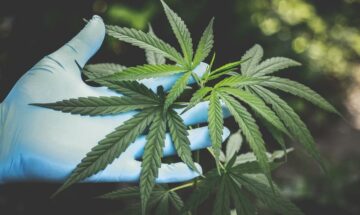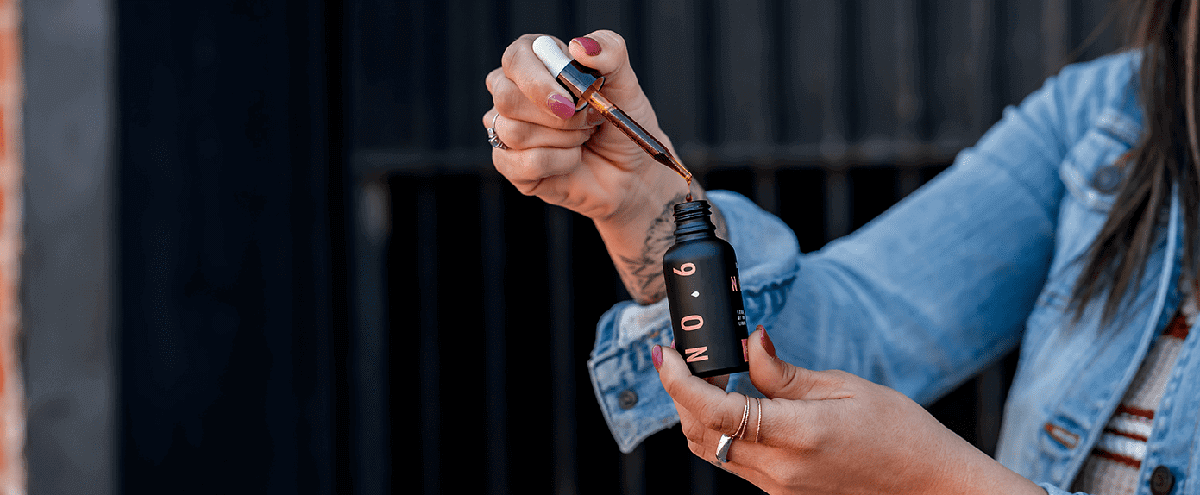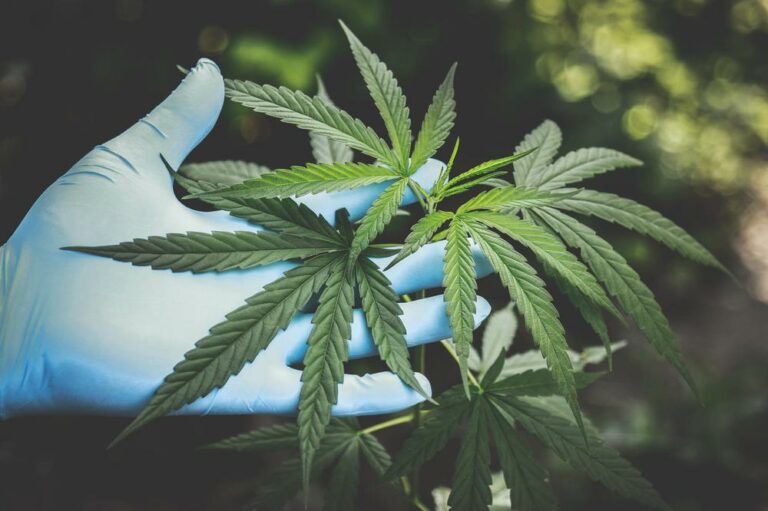
- Acne is a common skin condition when body oil and dead skin cells clog hair follicles(1). Pimples, blackheads, and whiteheads are among the most common types of acne.
- Cannabidiol (CBD) oil may help reduce inflammation(2). Inflammation deep inside hair follicles can lead to acne(3).
- A medical study in the Journal of Clinical Investigation in 2014 noted that CBD functions as a sebostatic agent(4).
- CBD’s purported effects on human sebocytes (sebum-producing cells) may help regulate sebum (skin oil) production and prevent build-up(5). Excessive synthesis of sebocytes can promote acne(6).
- Consulting a medical practitioner before using CBD products is recommended for dosing guidance and safety.
How Does CBD Oil Work on Acne?
The human endocannabinoid system (ECS) includes a complex network of cannabinoids and cannabinoid receptors that affect numerous body functions(7).
Additionally, the ECS collects and processes signals from cannabinoids, such as CBD. Studies in recent years suggest the existence of skin-based cannabinoid signaling(8).
The signaling is primarily involved in maintaining skin stability and the generation and regeneration of skin barriers.
Obstacles that block the signaling process may become a factor that leads to numerous skin diseases and disorders, including acne, psoriasis, pigmentation disorders, acne, tumors, and itchiness(9).
Research suggests the primary function of skin ECS is to regulate growth, survival, differentiation, and immune tolerance within skin cells(10).
The endocannabinoids on skin cells activate CB1 and CB2 receptors, which help suppress cell generation, inflammation, and death(11).
CB1 receptors are also involved in various body functions, including motor regulation, appetite, sleep, and memory processing(12).
Meanwhile, several CB2 receptors exist in immune system cells. Upon activation, CB2 receptors help reduce pain, suppress inflammation, and minimize tissue damage(13).
CB2 receptors may help manage skin diseases caused by various sebaceous gland dysfunctions(14). CBD products with high concentrations of CBD may help relieve acne symptoms by regulating sebum production.
Possible Benefits of CBD for Acne
The best CBD products contain high concentrations of CBD that may provide therapeutic benefits to help with acne symptoms.
Inflammation Reduction
High-quality CBD oil, in particular, may help soothe acne-produced irritation. This reaction may reduce the skin’s overall redness and cause acne breakouts to become less painful and appear smaller(15).
Such results may benefit acne-prone skin sensitivity. Skincare products with conventional active ingredients may produce symptoms such as redness, dryness, or irritation.
Antioxidant Properties
CBD oil contains antioxidants that may protect the skin from free radicals originating from environmental damage. Free radicals are molecules containing oxygen with an odd number of electrons(16).
A study published in the journal Antioxidants noted that, over time, CBD antioxidants may improve skin texture and tone(17).
The researchers were unable to determine if CBD oil can cause post-acne marks to fade. Nevertheless, CBD may provide additional antioxidant protection for daily anti-acne routines.
Oil Production Control
Studies conducted by researchers led by Attila Oláh show that CBD oil may help reduce the skin’s oil production due to its “sebostatic” feature(18).
Sebum production results from the sebaceous glands producing endogenous cannabinoids(19). These internal cannabinoids interact with CB2 receptors, which in turn regulate sebum production(20).
Bacterial Infection Relief
A small amount of bacteria on the skin may contaminate infection-causing clogged hair follicles(21).
Pimples develop on the skin when bacteria causes clogged hair follicles to become infected or inflamed(22).
C. sativa extracts, such as CBD, may contain antimicrobial properties for combating disease-causing bacteria, according to a 2020 study(23) published in the journal Antibiotics.
Overall Skin Health
CBD oil products may improve overall issues that trigger acne formation rather than merely function as cutaneous spot treatments on the skin.
This characteristic relates to CBD’s potential function of lowering oil production and its anti-inflammatory properties(24).
How to Use CBD Oil on Acne
When applying CBD to acne, various cannabidiol products are available on the market.
Edible CBD products include CBD-infused gummies, cookies, and chewing gum. Topical CBD products include CBD patches, massage oils, lotions, creams, and salves.
Consumers often use topical treatments for acne and other skin conditions. CBD topicals may be applied directly to target surface areas to address acne-related skin issues.
CBD creams are one option for acne breakouts or scars. They sometimes include moisturizers, such as shea butter or coconut oil, which individuals can use on their faces.
CBD users can also apply CBD hemp oils to the skin directly. They should, however, consider using CBD with seed oils like hempseed oil as a carrier oil.
Hempseed oil may help reduce adverse skin reactions, such as inflammation(25).
Meanwhile, CBD edibles like capsules and gummies in various concentrations are possible alternatives for daily acne symptom management.
Still, it is critical for individuals looking to use CBD for acne to consult with their doctor or dermatologist about the proper dosage.
CBD dosage may differ based on several factors, like age, type of acne, severity of symptoms, and method of administration.
CBD Oil and Body Acne
Oil glands are all over the body, not only on the face. Thus, acne also appears on the chest, shoulders, and upper back.
CBD skincare products for body acne may come in the form of soap bars, bath bombs, and lotions.
Acne skincare products may not be specifically advertised as anti-acne products. Still, these products may provide relief through CBD’s purported antibacterial and anti-inflammatory effects(26).
CBD and Acne Scar Treatment
Acne scars result from inflamed blemishes due to skin pores clogged with bacteria, extra oil, and dead skin cells(27). Squeezing pimples improperly may lead to more severe acne, infection, and permanent acne scars(28).
A 2019 study that included the University of Modena published in the journal La Clinica Terapeutica(29) examined study participants with skin conditions that included psoriasis. This skin disease causes red, itchy, and flaky patches(30).
The subjects with inflammatory skin conditions applied CBD ointments to scarred skin twice daily.
The researchers observed that after three months, the CBD ointment significantly improved the skin’s general appearance related to hydration and elasticity(31). In addition, the subjects experienced a reduction in inflammation and various scars(32).
The study included a small sample size and was not performed on individuals with acne scars(33). Nevertheless, the results suggest that CBD products may potentially help decrease acne scars’ appearance.
How Safe Is CBD Oil for Acne?
In 2017, the journal Cannabis and Cannabinoid Research deemed CBD to possess a favorable safety profile(34).
Researchers reported the most typical side-effects from taking CBD oil included:
- Fatigue
- Dry mouth
- Changes in appetite
- Diarrhea
People often experience these side effects by taking CBD in capsule form or under the tongue rather than topically(35).
Meanwhile, CBD users may experience itching, swelling, and skin peeling after applying CBD-infused products. These symptoms can be alleviated by washing the irritated area with water and applying a cold compress.
Possible Risks and Side Effects of Using CBD on Acne
One should consider the potential side effects of CBD oil for acne before using it.
The USA’s Food and Drug Administration (FDA) has not approved prescription acne treatments containing cannabidiol. Various over-the-counter (OTC) products, however, are available on the market.
Users of CBD oil and other CBD products may experience varying results. Initial low dosage is typically advised before increasing the amount of CBD topicals, for instance.
One should also consult with a doctor, preferably a dermatologist experienced in cannabis use, for guidance on the proper CBD dosage and administration.
CBD is typically deemed to be safe and well tolerated(36). Side effects are typically mild and include drowsiness, weight changes, appetite changes, and diarrhea(37).
CBD Usage for Other Skin Conditions
CBD may also provide benefits for relieving the symptoms of other skin conditions.
CBD for Sensitive Skin
Some skin types are particularly sensitive to environmental stressors or prone to allergic reactions.
No studies, including those by the National Institutes of Health (NIH), have been conducted on the effects of cannabidiol to relieve sensitive skin. Still, CBD’s purported anti-inflammatory and analgesic properties may help(38).
CBD for Psoriasis
While acne and psoriasis are two different skin problems, both are related to inflammation. A 2019 study(39) noted that CBD may help relieve inflammatory skin diseases such as psoriasis.
Meanwhile, other research suggests that CBD may help reduce the symptoms of psoriasis. Cannabinoids may inhibit the proliferation of keratinocytes (skin cells) through a mechanism not involving CB1 and CB2 receptors(40).
Psoriasis is characterized by the hyperproliferation of keratinocytes in the epidermis, the outermost layer of the skin.
CBD for Itchy Skin
A condition known as atopic dermatitis or eczema causes dry skin. This condition can cause rashes or itchy skin on the face, elbows, knees, hands, and feet(41).
Eczema is a chronic health condition that has no cure. It may, however, include periods of remission.
Limited scientific research exists for the use of CBD to relieve eczema symptoms. A 2019 study, published in Clinical Therapeutics, examined some people with atopic dermatitis(42).
Results of the study showed that a CBD ointment helped clear the subjects’ skin, reduced itch, and improved their sleep.
CBD may help relieve eczema symptoms while helping rebuild the skin’s protective barrier(43).
CBD for Wrinkles
No medical studies have been specifically conducted on the use of cannabidiol to reduce wrinkles.
Still, CBD’s antioxidant properties(44) may help reduce the visible signs of aging skin. Antioxidants counter the damage effects of free radicals.
Research suggests that CBD improves the production of collagen(45), making connective tissues and bones stronger and skin and muscles firmer. This reaction may help make wrinkles less visible.
CBD Legality
In 2018, the U.S. Congress passed a bill known as the Agricultural Improvement Act or Farm Bill. The bill legalized industrial hemp on the federal level.
The FDA states that a cannabis plant with under 0.3% tetrahydrocannabinol (THC) is classified as hemp(46). If the cannabis plant contains over 0.3% THC, it is classified as marijuana.
THC is the psychoactive chemical compound contained in marijuana, which causes a mind-altering effect. Meanwhile, the hemp plant’s lower CBD levels do not produce the same psychoactive effect.
Other non-psychoactive chemical compounds in cannabis plants include the aromatic compound, terpenes(47).
The legality of CBD may be confusing to consumers as the chemical compound can be derived from either marijuana or hemp plants such as Cannabis sativa L. Both plants are types of cannabis plants.
Consumers looking to try CBD products for acne are advised to research applicable state and local laws regarding CBD use.
What Is Acne and What Causes It?
Acne transpires when hair follicles become clogged with oil and dead skin cells, resulting in pimples, whiteheads, and blackheads(48).
Acne vulgaris is a common variety of acne characterized by inflammatory and non-inflammatory skin lesions(49).
A common misconception among individuals is that acne exclusively affects teenagers and adolescents(50). However, the skin condition can continue through adulthood.
According to the American Academy of Dermatology Association (AADA), acne may lead to anxiety and poor self-esteem, affecting mental health(51).
The objective of acne treatment is to aid in healing existing acne lesions, prevent the formation of new lesions, and avert scarring of the skin(52).
Numerous OTC acne treatments are available. Various alternative therapies, including hemp extracts like CBD products, may also help relieve and reduce acne symptoms.
People with acne should consult a physician before using a CBD product. A medical practitioner can provide guidance on dosing and possible drug interactions.
Alternative Natural Remedies for Acne
Several natural and herbal remedies may help relieve acne symptoms through purported anti-inflammatory properties and reduced sebum production(53).
- Tea tree oil
- Zinc
- Brewer’s yeast
However, more research is necessitated to validate their efficacy.
It is highly recommended to see a doctor before trying these OTC products and natural remedies for acne.
FAQs
1. How much CBD product should one use?
The U.S. FDA does not provide a specific CBD dosage recommendation for treating acne, and no industry standard dosages exist. It is recommended to get CBD oil help from one’s doctor for guidance on dosing.
2. What types of CBD topicals are available?
CBD isolates are a variety of pure CBD. Full-spectrum CBD is a hemp extract with all the natural chemical components of hemp plants(54).
Meanwhile, broad-spectrum CBD is full-spectrum CBD oil with virtually no THC(55) following the initial extraction process.
3. What is the best CBD dosage for acne?
No recommended CBD dose has been set for any medical condition, including acne. Consider commencing with a low amount, then gradually add to the dosage if well tolerated or no adverse reaction occurs.
Before using CBD to treat acne symptoms, consulting a medical professional experienced in medical cannabis is advisable.
4. What factors should be considered when choosing CBD products?
To find the best CBD oil, consider:
- Locally-grown hemp
- State and federal legal stipulations
- Extraction methods, such as CO2 extraction
- Certificate of Analysis (COA)
- Online product reviews
Conclusion
A holistic (whole-body) approach to healthy skin may include more than a daily skincare routine.
A healthy diet, an active lifestyle, and stress management(56) may help promote acne-prone skin.
Studies suggest that CBD may help relieve or reduce acne symptoms. However, CBD also involves potential risks and side effects, and scientists have not yet evaluated CBD’s long-term effects.
Before trying CBD for acne, consult a dermatology professional preferably experienced in medical marijuana or cannabis use.
- Acne https://www.mayoclinic.org/diseases-conditions/acne/symptoms-causes/syc-20368047
- Antioxidative and Anti-Inflammatory Properties of Cannabidiol https://www.ncbi.nlm.nih.gov/pmc/articles/PMC7023045/
- Acne https://www.mayoclinic.org/diseases-conditions/acne/symptoms-causes/syc-20368047
- Cannabidiol exerts sebostatic and antiinflammatory effects on human sebocytes https://www.ncbi.nlm.nih.gov/pmc/articles/PMC4151231/
- ibid.
- ibid.
- An introduction to the endogenous cannabinoid system https://www.ncbi.nlm.nih.gov/pmc/articles/PMC4789136/
- Cannabinoid Signaling in the Skin: Therapeutic Potential of the “C(ut)annabinoid” System https://www.ncbi.nlm.nih.gov/pmc/articles/PMC6429381/
- Cannabinoid Signaling in the Skin: Therapeutic Potential of the “C(ut)annabinoid” System https://www.ncbi.nlm.nih.gov/pmc/articles/PMC6429381/
- The endocannabinoid system of the skin in health and disease: novel perspectives and therapeutic opportunities https://www.ncbi.nlm.nih.gov/pmc/articles/PMC2757311/
- ibid.
- A look at endocannabinoid systems CB1 and CB2 receptors https://echoconnection.org/look-endocannabinoid-systems-cb1-cb2-receptors/
- The CB2 receptor and its role as a regulator of inflammation https://doi.org/10.1007/s00018-016-2300-4
- Endocannabinoids enhance lipid synthesis and apoptosis of human sebocytes via cannabinoid receptor-2-mediated signaling https://faseb.onlinelibrary.wiley.com/doi/10.1096/fj.07-104877
- A therapeutic effect of cbd-enriched ointment in inflammatory skin diseases and cutaneous scars https://www.clinicaterapeutica.it/2019/170/2/05_PALMIERI-VADALA.pdf
- Free radicals, antioxidants and functional foods: Impact on human health https://www.ncbi.nlm.nih.gov/pmc/articles/PMC3249911/
- Antioxidative and Anti-Inflammatory Properties of Cannabidiol https://www.ncbi.nlm.nih.gov/pmc/articles/PMC7023045/
- Cannabidiol exerts sebostatic and antiinflammatory effects on human sebocytes https://pubmed.ncbi.nlm.nih.gov/25061872/
- The endocannabinoid system of the skin in health and disease: novel perspectives and therapeutic opportunities https://www.ncbi.nlm.nih.gov/pmc/articles/PMC2757311/
- Cannabidiol exerts sebostatic and antiinflammatory effects on human sebocytes https://www.ncbi.nlm.nih.gov/pmc/articles/PMC4151231/
- Acne causes https://www.nhs.uk/conditions/acne/causes/
- Acne https://www.mayoclinic.org/diseases-conditions/acne/symptoms-causes/syc-20368047
- The Antimicrobial Activity of Cannabinoids https://www.ncbi.nlm.nih.gov/pmc/articles/PMC7400265/
- Cannabidiol exerts sebostatic and antiinflammatory effects on human sebocytes https://www.ncbi.nlm.nih.gov/pmc/articles/PMC4151231/
- The ameliorative effect of hemp seed hexane extracts on the Propionibacterium acnes-induced inflammation and lipogenesis in sebocytes https://www.ncbi.nlm.nih.gov/pmc/articles/PMC6110517/
- The Antimicrobial Activity of Cannabinoids https://www.ncbi.nlm.nih.gov/pmc/articles/PMC7400#5/
- Acne scars https://www.asds.net/skin-experts/skin-conditions/acne-scars
- Pimple popping: why only a dermatologist should do it https://www.aad.org/public/diseases/acne/skin-care/popping
- A therapeutic effect of cbd-enriched ointment in inflammatoryskin diseases and cutaneous scars https://www.clinicaterapeutica.it/2019/170/2/05_PALMIERI-VADALA.pdf
- Psoriasis https://www.mayoclinic.org/diseases-conditions/psoriasis/symptoms-causes/syc-20355840
- A therapeutic effect of cbd-enriched ointment in inflammatory skin diseases and cutaneous scars https://www.clinicaterapeutica.it/2019/170/2/05_PALMIERI-VADALA.pdf
- ibid.
- ibid.
- An Update on Safety and Side Effects of Cannabidiol: A Review of Clinical Data and Relevant Animal Studies https://www.ncbi.nlm.nih.gov/pmc/articles/PMC5569602/
- ibid.
- Cannabidiol Adverse Effects and Toxicity https://pubmed.ncbi.nlm.nih.gov/31161980/
- What are the benefits of CBD–and is it safe to use? https://www.mayoclinic.org/healthy-lifestyle/consumer-health/expert-answers/is-cbd-safe-and-effective/faq-20446700
- Cannabinoids in the management of difficult to treat pain https://www.ncbi.nlm.nih.gov/pmc/articles/PMC2503660/
- A therapeutic effect of cbd-enriched ointment in inflammatoryskin diseases and cutaneous scars https://www.clinicaterapeutica.it/2019/170/2/05_PALMIERI-VADALA.pdf
- Cannabinoids inhibit human keratinocyte proliferation through a non-CB1/CB2 mechanism and have a potential therapeutic value in the treatment of psoriasis https://pubmed.ncbi.nlm.nih.gov/17157480/
- Atopic dermatitis (eczema) https://www.mayoclinic.org/diseases-conditions/atopic-dermatitis-eczema/symptoms-causes/syc-20353273
- A therapeutic effect of cbd-enriched ointment in inflammatory skin diseases and cutaneous scars https://pubmed.ncbi.nlm.nih.gov/30993303/
- Therapeutic Potential of Cannabidiol (CBD) for Skin Health and Disorders https://www.ncbi.nlm.nih.gov/pmc/articles/PMC7736837/
- Antioxidative and Anti-Inflammatory Properties of Cannabidiol https://www.ncbi.nlm.nih.gov/pmc/articles/PMC7023045/
- Cannabidiol, a Major Non-Psychotropic Cannabis Constituent Enhances Fracture Healing and Stimulates Lysyl Hydroxylase Activity in Osteoblasts https://asbmr.onlinelibrary.wiley.com/doi/full/10.1002/jbmr.2513#
- Statement from FDA Commissioner Scott Gottlieb, M.D., on signing of the Agriculture Improvement Act and the agency’s regulation of products containing cannabis and cannabis-derived compounds https://www.fda.gov/news-events/press-announcements/statement-fda-commissioner-scott-gottlieb-md-signing-agriculture-improvement-act-and-agencys
- Clinicians’ Guide to Cannabidiol and Hemp Oils https://www.mayoclinicproceedings.org/article/S0025-6196(19)30007-2/fulltext
- Acne https://www.mayoclinic.org/diseases-conditions/acne/symptoms-causes/syc-20368047
- Acne vulgaris https://dermnetnz.org/topics/acne-vulgaris#:~:text=Acne%20vulgaris%20is%20the%20common,spots%22%20or%20%22zits%22
- Acne https://www.health.harvard.edu/a_to_z/acne-a-to-z
- Acne can affect more than your skin https://www.aad.org/public/diseases/acne/acne-emotional-effects
- What is acne? https://www.niams.nih.gov/health-topics/acne
- Natural acne treatments – what’s most effective? https://www.mayoclinic.org/diseases-conditions/acne/expert-answers/natural-acne-treatment/faq-20057915
- Full spectrum cbd oil: what is it and how does it work? https://cfah.org/what-is-full-spectrum-cbd/
- Cannabidiol primer for healthcare professionals https://www.ncbi.nlm.nih.gov/pmc/articles/PMC7340472/
- Acne Can Affect More Than Your Skin https://www.aad.org/public/diseases/acne/acne-emotional-effects













